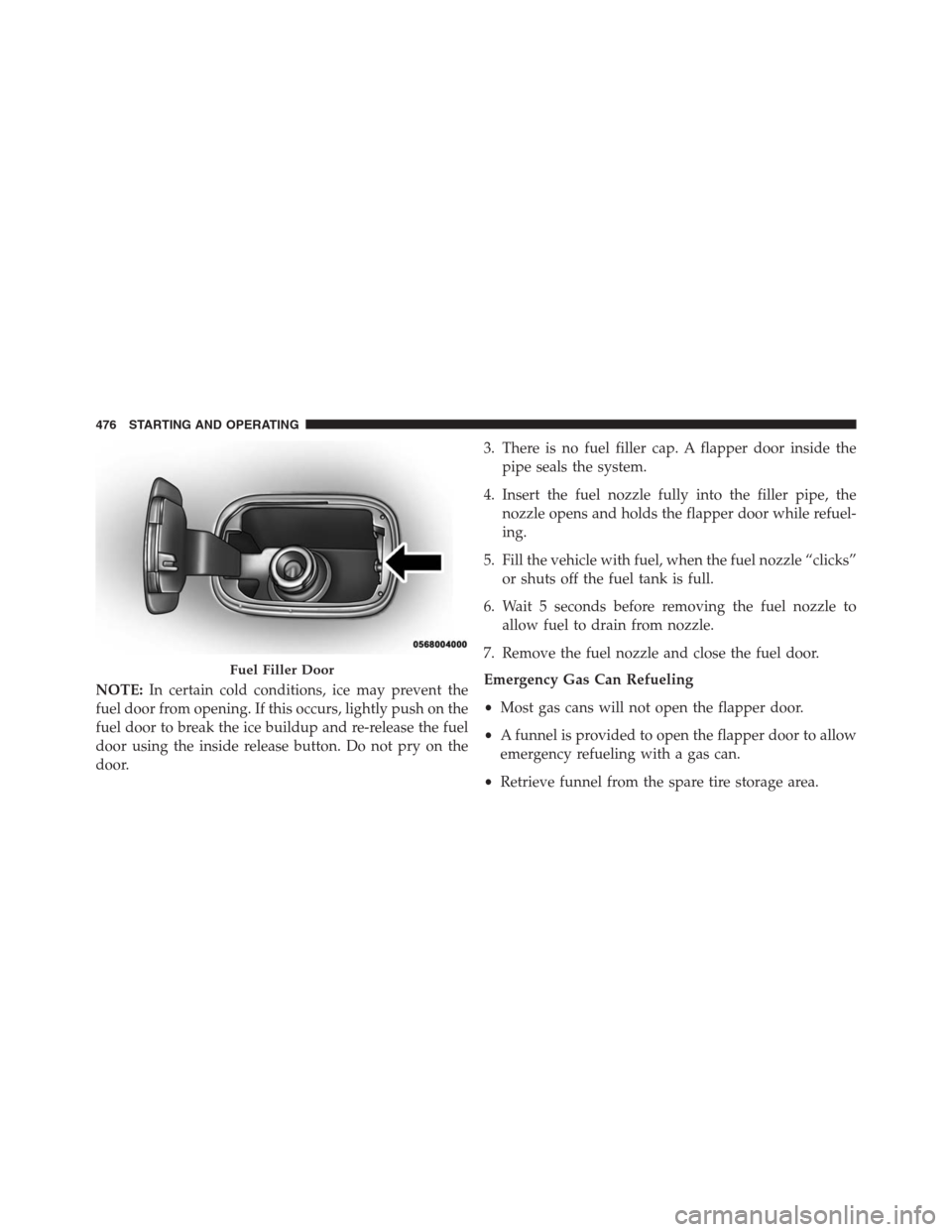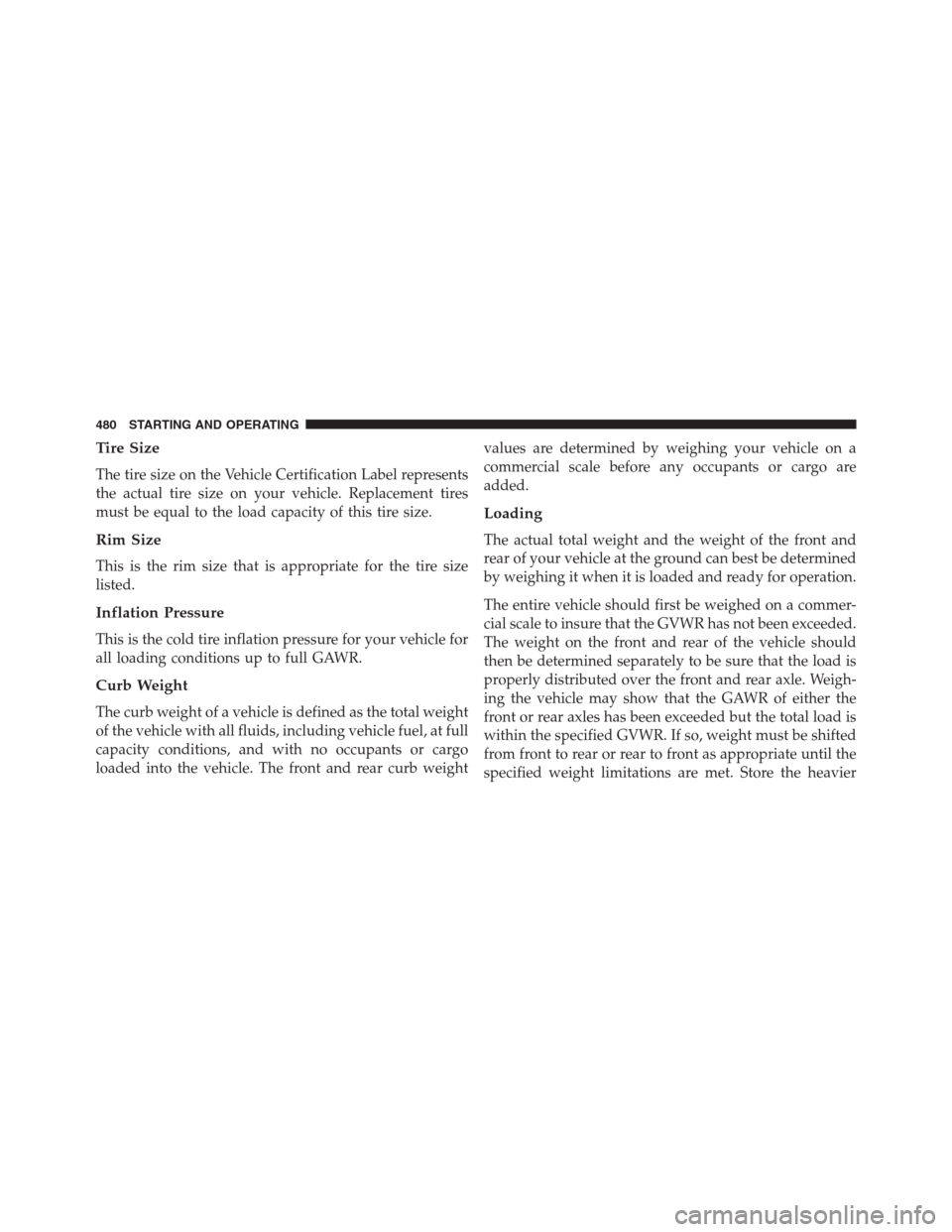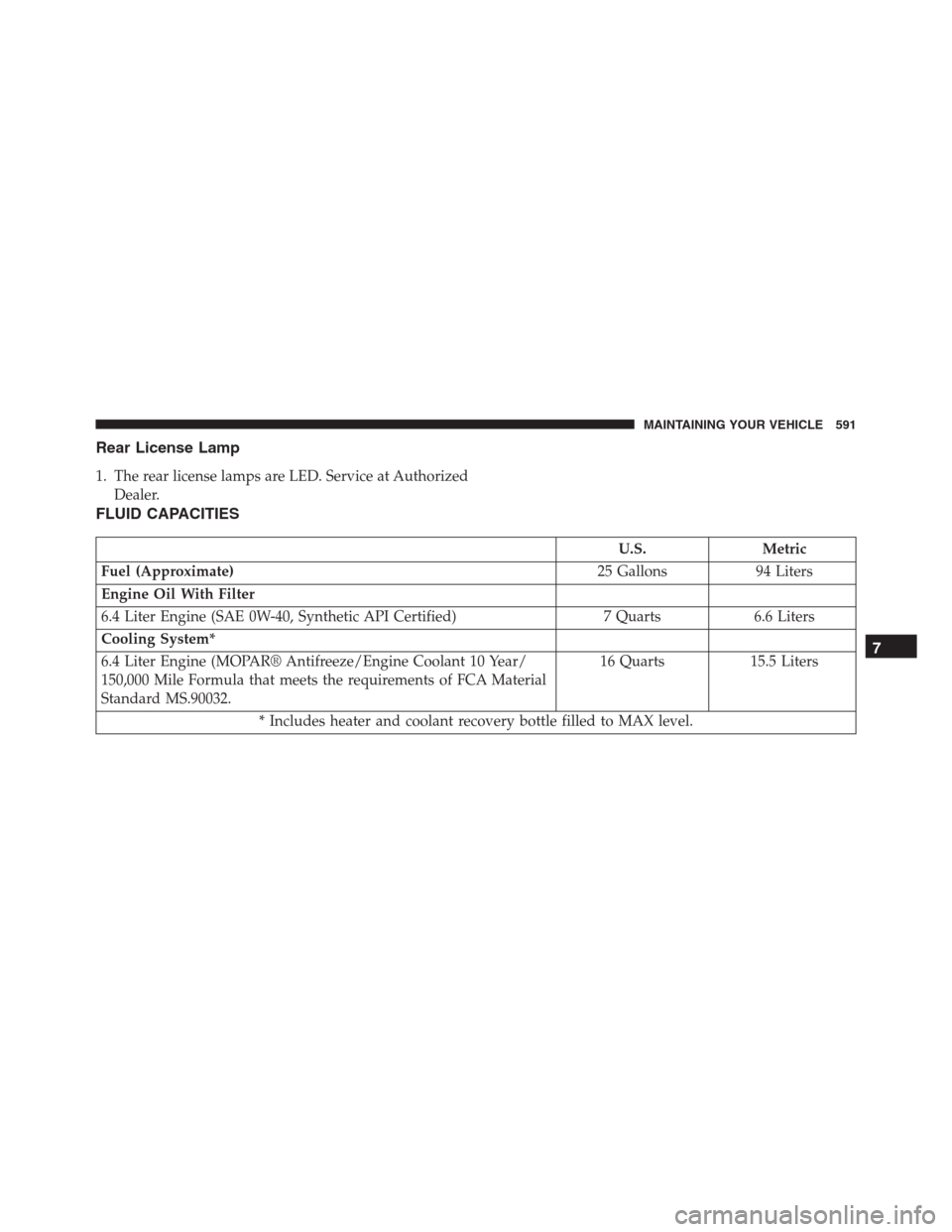2015 JEEP GRAND CHEROKEE fuel cap
[x] Cancel search: fuel capPage 467 of 636

CAUTION!(Continued)
cause the Tire Pressure Monitoring System (TPMS)
sensor to become inoperable. After using an after-
market tire sealant it is recommended that you take
your vehicle to an authorized dealership to have
your sensor function checked.
•After inspecting or adjusting the tire pressure,
always reinstall the valve stem cap. This will
prevent moisture and dirt from entering the valve
stem, which could damage the Tire Pressure Moni-
toring Sensor.
NOTE:
•The TPMS is not intended to replace normal tire care
and maintenance, or to provide warning of a tire
failure or condition.
•The TPMS should not be used as a tire pressure gauge
while adjusting your tire pressure.•Driving on a significantly under-inflated tire causes
the tire to overheat and can lead to tire failure.
Under-inflation also reduces fuel efficiency and tire
tread life, and may affect the vehicle’s handling and
stopping ability.
•The TPMS is not a substitute for proper tire mainte-
nance, and it is the driver ’s responsibility to maintain
correct tire pressure using an accurate tire gauge, even
if under-inflation has not reached the level to trigger
illumination of the Tire Pressure Monitoring Telltale
Light.
•Seasonal temperature changes will affect tire pressure,
and the TPMS will monitor the actual tire pressure in
the tire.
Premium System
The Tire Pressure Monitor System (TPMS) uses wireless
technology with wheel rim-mounted electronic sensors to
5
STARTING AND OPERATING 465
Page 478 of 636

NOTE:In certain cold conditions, ice may prevent the
fuel door from opening. If this occurs, lightly push on the
fuel door to break the ice buildup and re-release the fuel
door using the inside release button. Do not pry on the
door.3. There is no fuel filler cap. A flapper door inside the
pipe seals the system.
4. Insert the fuel nozzle fully into the filler pipe, the
nozzle opens and holds the flapper door while refuel-
ing.
5. Fill the vehicle with fuel, when the fuel nozzle “clicks”
or shuts off the fuel tank is full.
6. Wait 5 seconds before removing the fuel nozzle to
allow fuel to drain from nozzle.
7. Remove the fuel nozzle and close the fuel door.
Emergency Gas Can Refueling
•Most gas cans will not open the flapper door.
•A funnel is provided to open the flapper door to allow
emergency refueling with a gas can.
•Retrieve funnel from the spare tire storage area.
Fuel Filler Door
476 STARTING AND OPERATING
Page 482 of 636

Tire Size
The tire size on the Vehicle Certification Label represents
the actual tire size on your vehicle. Replacement tires
must be equal to the load capacity of this tire size.
Rim Size
This is the rim size that is appropriate for the tire size
listed.
Inflation Pressure
This is the cold tire inflation pressure for your vehicle for
all loading conditions up to full GAWR.
Curb Weight
The curb weight of a vehicle is defined as the total weight
of the vehicle with all fluids, including vehicle fuel, at full
capacity conditions, and with no occupants or cargo
loaded into the vehicle. The front and rear curb weightvalues are determined by weighing your vehicle on a
commercial scale before any occupants or cargo are
added.
Loading
The actual total weight and the weight of the front and
rear of your vehicle at the ground can best be determined
by weighing it when it is loaded and ready for operation.
The entire vehicle should first be weighed on a commer-
cial scale to insure that the GVWR has not been exceeded.
The weight on the front and rear of the vehicle should
then be determined separately to be sure that the load is
properly distributed over the front and rear axle. Weigh-
ing the vehicle may show that the GAWR of either the
front or rear axles has been exceeded but the total load is
within the specified GVWR. If so, weight must be shifted
from front to rear or rear to front as appropriate until the
specified weight limitations are met. Store the heavier
480 STARTING AND OPERATING
Page 507 of 636

Jack Location
The scissor-type jack and tire changing tools are located
in rear cargo area, below the load floor.NOTE:The funnel for the Cap-Less Fuel System is
located on top of the spare tire. If your vehicle is out of
fuel and an auxiliary fuel can is needed, insert the funnel
into the filler neck and proceed to fill the vehicle. For
vehicles not equipped with a spare tire, the fuel filler
funnel is stored in the left storage bin under the load
floor. For more information on the Cap-Less Fuel System
refer to “Adding Fuel” in “Starting And Operating” in
this manual.
Spare Tire Stowage
The spare tire is stowed under the load floor in the rear
cargo area and is secured to the body with a special wing
nut.
Preparations For Jacking
1. Park the vehicle on a firm, level surface. Avoid ice or
slippery surfaces.Jack Storage Location
6
WHAT TO DO IN EMERGENCIES 505
Page 593 of 636

Rear License Lamp
1. The rear license lamps are LED. Service at Authorized
Dealer.
FLUID CAPACITIES
U.S. Metric
Fuel (Approximate)25 Gallons 94 Liters
Engine Oil With Filter
6.4 Liter Engine (SAE 0W-40, Synthetic API Certified) 7 Quarts 6.6 Liters
Cooling System*
6.4 Liter Engine (MOPAR® Antifreeze/Engine Coolant 10 Year/
150,000 Mile Formula that meets the requirements of FCA Material
Standard MS.90032.16 Quarts 15.5 Liters
* Includes heater and coolant recovery bottle filled to MAX level.
7
MAINTAINING YOUR VEHICLE 591
Page 621 of 636

Fails To Start..........................402
Flooded, Starting.......................402
Fuel Requirements...................471, 591
Jump Starting..........................514
Oil ...........................532, 591, 592
Oil Change Interval......................532
Oil Filler Cap.......................533, 534
Oil Filter.............................535
Oil Selection.......................533, 591
Oil Synthetic..........................534
Overheating...........................500
Starting..............................399
Temperature Gauge......................286
Engine Oil Viscosity....................533, 534
Enhanced Accident Response Feature............78
Entry System, Illuminated....................22
Ethanol................................471
Event Data Recorder........................81
Exhaust Gas Caution...................108, 474Exhaust System.......................108, 554
Exterior Lights...........................111
Filters
Air Cleaner...........................535
Air Conditioning.................377, 536, 542
Engine Oil.........................535, 592
Engine Oil Disposal.....................534
Flashers................................500
Hazard Warning........................500
Turn Signal..................111,286, 587, 588
Flooded Engine Starting....................402
Fluid, Brake.............................593
Fluid Capacities..........................591
Fluid Leaks.............................112
Fluid Level Checks
Brake................................563
Cooling System.........................556
Engine Oil............................532
10
INDEX 619
Page 622 of 636

Fluids, Lubricants And Genuine Parts...........592
Fog Lights...........................286, 587
Fog Light Service.........................587
Folding Rear Seat.........................156
Forward Collision Warning..................214
Four-Way Hazard Flasher...................500
Freeing A Stuck Vehicle.....................519
Front Axle (Differential).....................564
Fuel...................................471
Adding..............................475
Additives.............................473
Clean Air.............................471
Economy Mode........................405
Ethanol..............................471
Gasoline..............................471
Gauge...............................286
Materials Added........................473
Methanol.............................471
Octane Rating......................471, 592Requirements.......................471, 591
Tank Capacity..........................591
Fueling................................475
Fuses..................................574
Garage Door Opener (HomeLink®).........242, 249
Gasoline, Clean Air........................471
Gasoline (Fuel)...........................471
Gasoline, Reformulated.....................471
Gauges
Coolant Temperature.....................286
Fuel.................................286
Speedometer..........................286
Tachometer............................286
Gear Ranges.............................409
General Information....................210, 470
Glass Cleaning
...........................572
Gross Axle Weight Rating...................482
Gross Vehicle Weight Rating..................481
620 INDEX
Page 626 of 636

Maintenance Schedule...................596, 598
Malfunction Indicator Light (Check Engine) . . .286, 528
Manual, Service..........................610
Memory Feature (Memory Seat)...............158
Memory Seat............................158
Memory Seats And Radio...................158
Methanol...............................471
Mirrors................................121
Electric Powered........................129
Electric Remote.........................129
Exterior Folding........................128
Heated...............................130
Outside..............................128
Rearview.............................121
Vanity...............................131
Modifications/Alterations, Vehicle...............9
Monitor, Tire Pressure System................463
MOPAR® Parts.......................530, 609
MTBE/ETBE............................471Multi-Function Control Lever.................164
Occupant Restraints........................49
Octane Rating, Gasoline (Fuel)................471
Odometer...............................286
Trip .................................286
Oil, Engine.......................299, 532, 592
Capacity.............................591
Change Interval........................532
Checking.............................532
Disposal..............................534
Filter.............................535, 592
Filter Disposal.........................534
Identification Logo......................533
Materials Added To......................534
Recommendation....................533, 591
Synthetic.............................534
Viscosity......................
.533, 534, 591
Oil Filter, Change.........................535
624 INDEX